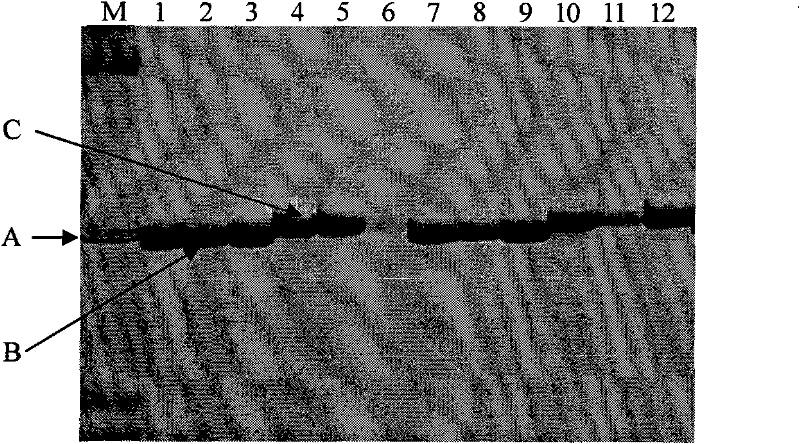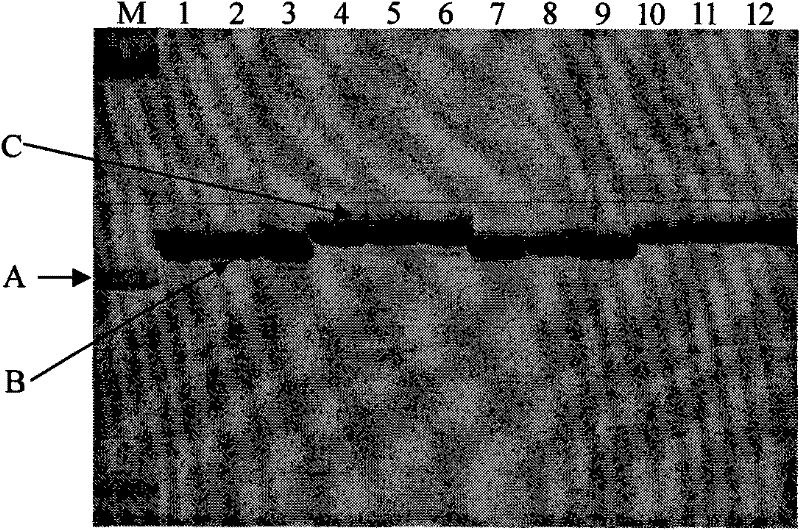Primer sequence for identifying resistance of cucumber against alternaria cucumerina and identification method thereof
A primer sequence, black spot technology, applied in the field of DNA sequences, can solve the problems of difficult black spot resistant materials, long breeding cycle, difficult control of the process of identifying resistant materials, etc., and achieves great application value without environmental protection Effects of Conditioning
- Summary
- Abstract
- Description
- Claims
- Application Information
AI Technical Summary
Problems solved by technology
Method used
Image
Examples
Embodiment 1
[0030] A method for identifying resistance to black spot disease of cucumber
[0031] (1) Extracting cucumber genomic DNA;
[0032] ] (2) PCR amplification is carried out, and 20ng of the cucumber genomic DNA, 30ng of the nucleotide sequence described in SEQ ID No1 in the sequence listing, and the nucleus described in SEQ ID No2 in the sequence listing are put into the thin-walled tube for PCR amplification nucleotide sequence 30ng, dNTP 0.2mM, Mg 2+1.5mM, 1 times PCR buffer, Taq DNA polymerase 1.0 unit, add sterile double distilled water to 20μl, put the thin-walled tube for PCR amplification into the PCR machine for amplification, and the amplification conditions are: 94°C Pre-denaturation for 200 seconds, denaturation at 94°C for 60 seconds, annealing at 57°C for 50 seconds, extension at 72°C for 90 seconds, 30 cycles, and extension at 72°C for 350 seconds, the amplification was completed;
[0033] (3) Gel electrophoresis analysis of PCR amplification products: The ampl...
Embodiment 2
[0036] A method for identifying resistance to black spot disease of cucumber
[0037] (1) Extracting cucumber genomic DNA;
[0038] (2) Carry out PCR amplification: put 15ng of the cucumber genomic DNA, 20ng of the nucleotide sequence described in SEQ ID No1 in the sequence listing, and the nucleus described in SEQ ID No2 in the sequence listing in a thin-walled tube dedicated to PCR amplification nucleotide sequence 20ng, dNTP 0.15mM, Mg 2+ 1.2mM, 1 times PCR buffer, Taq DNA polymerase 0.8 units, add sterile double distilled water to 20μl, put the thin-walled tube for PCR amplification into the PCR machine for amplification, and the amplification conditions are: 94°C Pre-denaturation for 180 seconds, denaturation at 94°C for 60 seconds, annealing at 60°C for 40 seconds, extension at 72°C for 60 seconds, 25 cycles, and extension at 72°C for 300 seconds, the amplification was completed;
[0039] (3) Gel electrophoresis analysis of PCR amplification products: The amplification...
Embodiment 3
[0042] A method for identifying resistance to black spot disease of cucumber
[0043] (1) Extracting cucumber genomic DNA;
[0044] (2) Carry out PCR amplification: put 30ng of the cucumber genomic DNA, 40ng of the nucleotide sequence described in SEQ ID No1 in the sequence listing, and the nucleus described in SEQ ID No2 in the sequence listing in a thin-walled tube dedicated to PCR amplification nucleotide sequence 40ng, dNTP 0.25mM, Mg 2+ 2.0mM, 1 times PCR buffer, 1.2 units of Taq DNA polymerase, add sterile double distilled water to 20μl, put the thin-walled tube for PCR amplification into the PCR machine for amplification, and the amplification conditions are: 94°C Pre-denaturation for 300 seconds, denaturation at 94°C for 60 seconds, annealing at 54°C for 60 seconds, extension at 72°C for 120 seconds, 35 cycles, and extension at 72°C for 420 seconds, the amplification was completed;
[0045] (3) Gel electrophoresis analysis of PCR amplification products: The amplifica...
PUM
 Login to View More
Login to View More Abstract
Description
Claims
Application Information
 Login to View More
Login to View More - R&D
- Intellectual Property
- Life Sciences
- Materials
- Tech Scout
- Unparalleled Data Quality
- Higher Quality Content
- 60% Fewer Hallucinations
Browse by: Latest US Patents, China's latest patents, Technical Efficacy Thesaurus, Application Domain, Technology Topic, Popular Technical Reports.
© 2025 PatSnap. All rights reserved.Legal|Privacy policy|Modern Slavery Act Transparency Statement|Sitemap|About US| Contact US: help@patsnap.com



